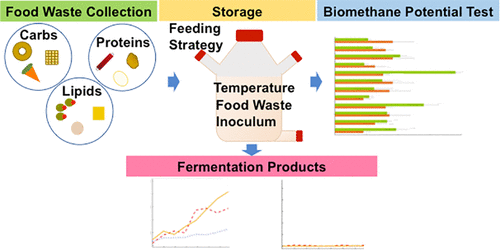当前位置:
X-MOL 学术
›
ACS Sustain. Chem. Eng.
›
论文详情
Our official English website, www.x-mol.net, welcomes your feedback! (Note: you will need to create a separate account there.)
Systematic Analysis of Factors That Affect Food-Waste Storage: Toward Maximizing Lactate Accumulation for Resource Recovery
ACS Sustainable Chemistry & Engineering ( IF 8.4 ) Pub Date : 2020-08-11 , DOI: 10.1021/acssuschemeng.0c03161 Sarah E. Daly 1 , Joseph G. Usack 1, 2 , Lauren A. Harroff 1 , James G. Booth 3 , Michael P. Keleman 4 , Largus T. Angenent 2
ACS Sustainable Chemistry & Engineering ( IF 8.4 ) Pub Date : 2020-08-11 , DOI: 10.1021/acssuschemeng.0c03161 Sarah E. Daly 1 , Joseph G. Usack 1, 2 , Lauren A. Harroff 1 , James G. Booth 3 , Michael P. Keleman 4 , Largus T. Angenent 2
Affiliation

|
In the U.S., several states have attempted to mitigate greenhouse-gas emissions by banning food wastes from landfills. As a result, U.S.-based companies are now providing decentralized food-waste management systems for supermarkets and restaurants, which include storage as a slurry. It is unclear, however, which storage conditions (factors) would affect the spontaneous microbial activity, resulting in a different fermentation product spectra, and how this would further affect post-treatment. Here, we performed two experiments to mimic: (1) storage and (2) subsequent anaerobic digestion. For the food-waste storage system, we designed a mixed-level fractional factorial analysis with 12 experimental combinations, including separating food waste into: carbohydrate-rich, lipid-rich, and protein-rich food waste. We found that all factors that we tested affected the fermentation outcome. We observed that relatively low pH levels of 3–4, which were achieved due to rapid lactate accumulation by microbial activity during storage, coincided with greater lactate production and a maximum chemical oxygen demand (COD) selectivity of 90%. Food-waste storage followed classical ensilage dynamics with homofermentation to lactate in combination with low pH preventing the subsequent breakdown of lacate into other carboxylic acids and hydrogen gas. The mechanistic understanding provides an opportunity to optimize lactate production, which is ideal for subsequent methane or chemical production.
中文翻译:

系统地分析影响食物废物存储的因素:争取最大限度地增加乳酸积累以进行资源回收
在美国,一些州试图通过禁止垃圾填埋场的食物垃圾来减少温室气体的排放。结果,总部位于美国的公司现在为超级市场和饭店提供分散的食品废物管理系统,其中包括将其作为浆液存储。但是,尚不清楚哪些储存条件(因素)会影响自发微生物的活性,从而导致不同的发酵产物光谱,以及这将如何进一步影响后处理。在这里,我们进行了两个模拟实验:(1)储存和(2)随后的厌氧消化。对于食物垃圾存储系统,我们设计了12种实验组合的混合级分数析因分析,包括将食物垃圾分为:富含碳水化合物,富含脂质和富含蛋白质的食物垃圾。我们发现,我们测试的所有因素均会影响发酵结果。我们观察到,相对较低的pH值3-4(由于在储存过程中由于微生物的活动而使乳酸迅速积累而实现)与较高的乳酸产量和90%的最大化学需氧量(COD)选择性相吻合。食品废物的储存遵循经典的青贮饲料动力学,将乳酸匀浆发酵并结合低pH值,可防止随后的Lacate分解为其他羧酸和氢气。机械学的理解为优化乳酸生产提供了机会,这对于后续甲烷或化学生产是理想的。与此同时,乳酸产量增加,最大化学需氧量(COD)选择性达到90%。食品废物的储存遵循经典的青贮饲料动力学,将乳酸匀浆发酵并结合低pH值,可防止随后的Lacate分解为其他羧酸和氢气。机械学的理解为优化乳酸生产提供了机会,这对于后续甲烷或化学生产是理想的。与此同时,乳酸产量增加,最大化学需氧量(COD)选择性达到90%。食品废物的储存遵循经典的青贮饲料动力学,将乳酸匀浆发酵并结合低pH值,可防止随后的Lacate分解为其他羧酸和氢气。机械学的理解为优化乳酸生产提供了机会,这对于后续甲烷或化学生产是理想的。
更新日期:2020-09-21
中文翻译:

系统地分析影响食物废物存储的因素:争取最大限度地增加乳酸积累以进行资源回收
在美国,一些州试图通过禁止垃圾填埋场的食物垃圾来减少温室气体的排放。结果,总部位于美国的公司现在为超级市场和饭店提供分散的食品废物管理系统,其中包括将其作为浆液存储。但是,尚不清楚哪些储存条件(因素)会影响自发微生物的活性,从而导致不同的发酵产物光谱,以及这将如何进一步影响后处理。在这里,我们进行了两个模拟实验:(1)储存和(2)随后的厌氧消化。对于食物垃圾存储系统,我们设计了12种实验组合的混合级分数析因分析,包括将食物垃圾分为:富含碳水化合物,富含脂质和富含蛋白质的食物垃圾。我们发现,我们测试的所有因素均会影响发酵结果。我们观察到,相对较低的pH值3-4(由于在储存过程中由于微生物的活动而使乳酸迅速积累而实现)与较高的乳酸产量和90%的最大化学需氧量(COD)选择性相吻合。食品废物的储存遵循经典的青贮饲料动力学,将乳酸匀浆发酵并结合低pH值,可防止随后的Lacate分解为其他羧酸和氢气。机械学的理解为优化乳酸生产提供了机会,这对于后续甲烷或化学生产是理想的。与此同时,乳酸产量增加,最大化学需氧量(COD)选择性达到90%。食品废物的储存遵循经典的青贮饲料动力学,将乳酸匀浆发酵并结合低pH值,可防止随后的Lacate分解为其他羧酸和氢气。机械学的理解为优化乳酸生产提供了机会,这对于后续甲烷或化学生产是理想的。与此同时,乳酸产量增加,最大化学需氧量(COD)选择性达到90%。食品废物的储存遵循经典的青贮饲料动力学,将乳酸匀浆发酵并结合低pH值,可防止随后的Lacate分解为其他羧酸和氢气。机械学的理解为优化乳酸生产提供了机会,这对于后续甲烷或化学生产是理想的。



























 京公网安备 11010802027423号
京公网安备 11010802027423号